20.5: Wound Dressings
- Page ID
- 44685
\( \newcommand{\vecs}[1]{\overset { \scriptstyle \rightharpoonup} {\mathbf{#1}} } \)
\( \newcommand{\vecd}[1]{\overset{-\!-\!\rightharpoonup}{\vphantom{a}\smash {#1}}} \)
\( \newcommand{\dsum}{\displaystyle\sum\limits} \)
\( \newcommand{\dint}{\displaystyle\int\limits} \)
\( \newcommand{\dlim}{\displaystyle\lim\limits} \)
\( \newcommand{\id}{\mathrm{id}}\) \( \newcommand{\Span}{\mathrm{span}}\)
( \newcommand{\kernel}{\mathrm{null}\,}\) \( \newcommand{\range}{\mathrm{range}\,}\)
\( \newcommand{\RealPart}{\mathrm{Re}}\) \( \newcommand{\ImaginaryPart}{\mathrm{Im}}\)
\( \newcommand{\Argument}{\mathrm{Arg}}\) \( \newcommand{\norm}[1]{\| #1 \|}\)
\( \newcommand{\inner}[2]{\langle #1, #2 \rangle}\)
\( \newcommand{\Span}{\mathrm{span}}\)
\( \newcommand{\id}{\mathrm{id}}\)
\( \newcommand{\Span}{\mathrm{span}}\)
\( \newcommand{\kernel}{\mathrm{null}\,}\)
\( \newcommand{\range}{\mathrm{range}\,}\)
\( \newcommand{\RealPart}{\mathrm{Re}}\)
\( \newcommand{\ImaginaryPart}{\mathrm{Im}}\)
\( \newcommand{\Argument}{\mathrm{Arg}}\)
\( \newcommand{\norm}[1]{\| #1 \|}\)
\( \newcommand{\inner}[2]{\langle #1, #2 \rangle}\)
\( \newcommand{\Span}{\mathrm{span}}\) \( \newcommand{\AA}{\unicode[.8,0]{x212B}}\)
\( \newcommand{\vectorA}[1]{\vec{#1}} % arrow\)
\( \newcommand{\vectorAt}[1]{\vec{\text{#1}}} % arrow\)
\( \newcommand{\vectorB}[1]{\overset { \scriptstyle \rightharpoonup} {\mathbf{#1}} } \)
\( \newcommand{\vectorC}[1]{\textbf{#1}} \)
\( \newcommand{\vectorD}[1]{\overrightarrow{#1}} \)
\( \newcommand{\vectorDt}[1]{\overrightarrow{\text{#1}}} \)
\( \newcommand{\vectE}[1]{\overset{-\!-\!\rightharpoonup}{\vphantom{a}\smash{\mathbf {#1}}}} \)
\( \newcommand{\vecs}[1]{\overset { \scriptstyle \rightharpoonup} {\mathbf{#1}} } \)
\(\newcommand{\longvect}{\overrightarrow}\)
\( \newcommand{\vecd}[1]{\overset{-\!-\!\rightharpoonup}{\vphantom{a}\smash {#1}}} \)
\(\newcommand{\avec}{\mathbf a}\) \(\newcommand{\bvec}{\mathbf b}\) \(\newcommand{\cvec}{\mathbf c}\) \(\newcommand{\dvec}{\mathbf d}\) \(\newcommand{\dtil}{\widetilde{\mathbf d}}\) \(\newcommand{\evec}{\mathbf e}\) \(\newcommand{\fvec}{\mathbf f}\) \(\newcommand{\nvec}{\mathbf n}\) \(\newcommand{\pvec}{\mathbf p}\) \(\newcommand{\qvec}{\mathbf q}\) \(\newcommand{\svec}{\mathbf s}\) \(\newcommand{\tvec}{\mathbf t}\) \(\newcommand{\uvec}{\mathbf u}\) \(\newcommand{\vvec}{\mathbf v}\) \(\newcommand{\wvec}{\mathbf w}\) \(\newcommand{\xvec}{\mathbf x}\) \(\newcommand{\yvec}{\mathbf y}\) \(\newcommand{\zvec}{\mathbf z}\) \(\newcommand{\rvec}{\mathbf r}\) \(\newcommand{\mvec}{\mathbf m}\) \(\newcommand{\zerovec}{\mathbf 0}\) \(\newcommand{\onevec}{\mathbf 1}\) \(\newcommand{\real}{\mathbb R}\) \(\newcommand{\twovec}[2]{\left[\begin{array}{r}#1 \\ #2 \end{array}\right]}\) \(\newcommand{\ctwovec}[2]{\left[\begin{array}{c}#1 \\ #2 \end{array}\right]}\) \(\newcommand{\threevec}[3]{\left[\begin{array}{r}#1 \\ #2 \\ #3 \end{array}\right]}\) \(\newcommand{\cthreevec}[3]{\left[\begin{array}{c}#1 \\ #2 \\ #3 \end{array}\right]}\) \(\newcommand{\fourvec}[4]{\left[\begin{array}{r}#1 \\ #2 \\ #3 \\ #4 \end{array}\right]}\) \(\newcommand{\cfourvec}[4]{\left[\begin{array}{c}#1 \\ #2 \\ #3 \\ #4 \end{array}\right]}\) \(\newcommand{\fivevec}[5]{\left[\begin{array}{r}#1 \\ #2 \\ #3 \\ #4 \\ #5 \\ \end{array}\right]}\) \(\newcommand{\cfivevec}[5]{\left[\begin{array}{c}#1 \\ #2 \\ #3 \\ #4 \\ #5 \\ \end{array}\right]}\) \(\newcommand{\mattwo}[4]{\left[\begin{array}{rr}#1 \amp #2 \\ #3 \amp #4 \\ \end{array}\right]}\) \(\newcommand{\laspan}[1]{\text{Span}\{#1\}}\) \(\newcommand{\bcal}{\cal B}\) \(\newcommand{\ccal}{\cal C}\) \(\newcommand{\scal}{\cal S}\) \(\newcommand{\wcal}{\cal W}\) \(\newcommand{\ecal}{\cal E}\) \(\newcommand{\coords}[2]{\left\{#1\right\}_{#2}}\) \(\newcommand{\gray}[1]{\color{gray}{#1}}\) \(\newcommand{\lgray}[1]{\color{lightgray}{#1}}\) \(\newcommand{\rank}{\operatorname{rank}}\) \(\newcommand{\row}{\text{Row}}\) \(\newcommand{\col}{\text{Col}}\) \(\renewcommand{\row}{\text{Row}}\) \(\newcommand{\nul}{\text{Nul}}\) \(\newcommand{\var}{\text{Var}}\) \(\newcommand{\corr}{\text{corr}}\) \(\newcommand{\len}[1]{\left|#1\right|}\) \(\newcommand{\bbar}{\overline{\bvec}}\) \(\newcommand{\bhat}{\widehat{\bvec}}\) \(\newcommand{\bperp}{\bvec^\perp}\) \(\newcommand{\xhat}{\widehat{\xvec}}\) \(\newcommand{\vhat}{\widehat{\vvec}}\) \(\newcommand{\uhat}{\widehat{\uvec}}\) \(\newcommand{\what}{\widehat{\wvec}}\) \(\newcommand{\Sighat}{\widehat{\Sigma}}\) \(\newcommand{\lt}{<}\) \(\newcommand{\gt}{>}\) \(\newcommand{\amp}{&}\) \(\definecolor{fillinmathshade}{gray}{0.9}\)Wound dressings should be selected based on the type of the wound, the cause of the wound, and the characteristics of the wound. A specially-trained wound care nurse should be consulted, when possible, for appropriate selection of dressings for chronic wounds. See Table \(\PageIndex{1}\) for commonly used wound dressings and associated nursing considerations.[1]
| Type of Dressing | Description | Nursing Considerations |
|---|---|---|
| Sterile gauze | Nonadherent dressing used on moderately to highly exudative wounds. Nontraumatic to wound bed and promotes a moist wound environment. |
|
| Foam (see Figure \(\PageIndex{7}\)[9]) | Nonadherent and absorptive. |
|
| Alginate/hydrofibers (see Figure \(\PageIndex{8}\)[10]) | Nonadherent and highly absorptive for highly exudative wounds. Used for wound packing in full-thickness wounds such as Stage 3 or 4 pressure injuries. |
|
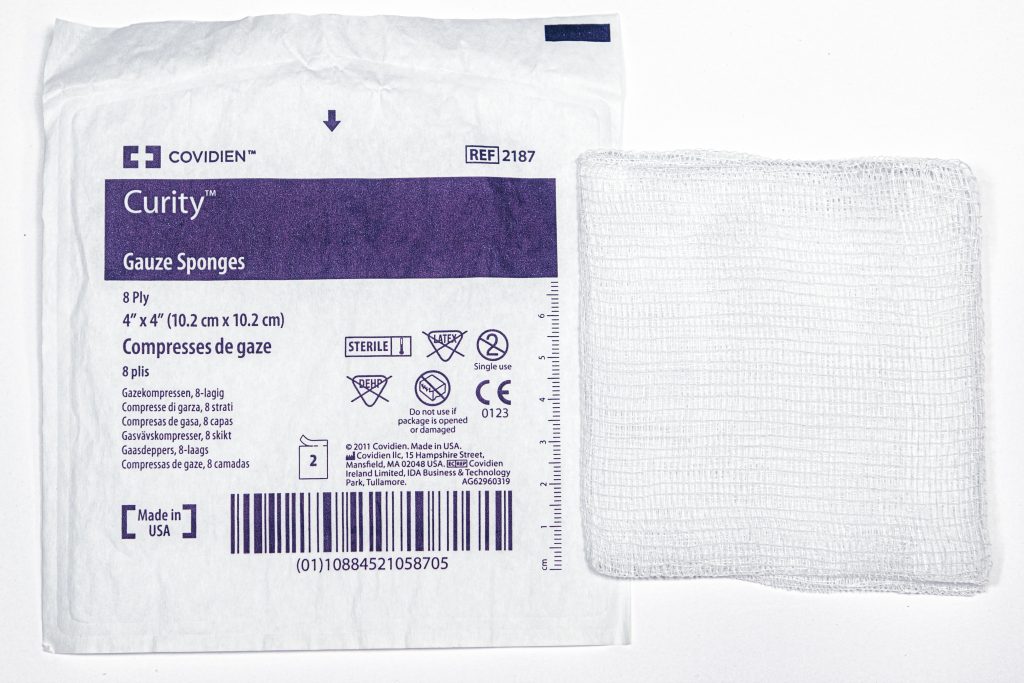
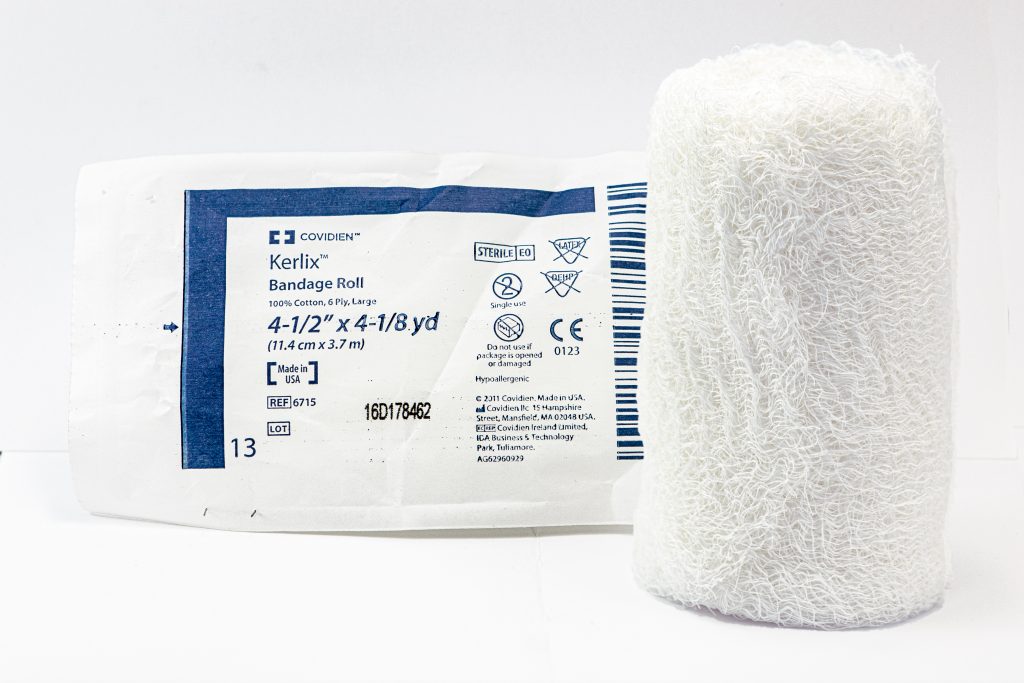
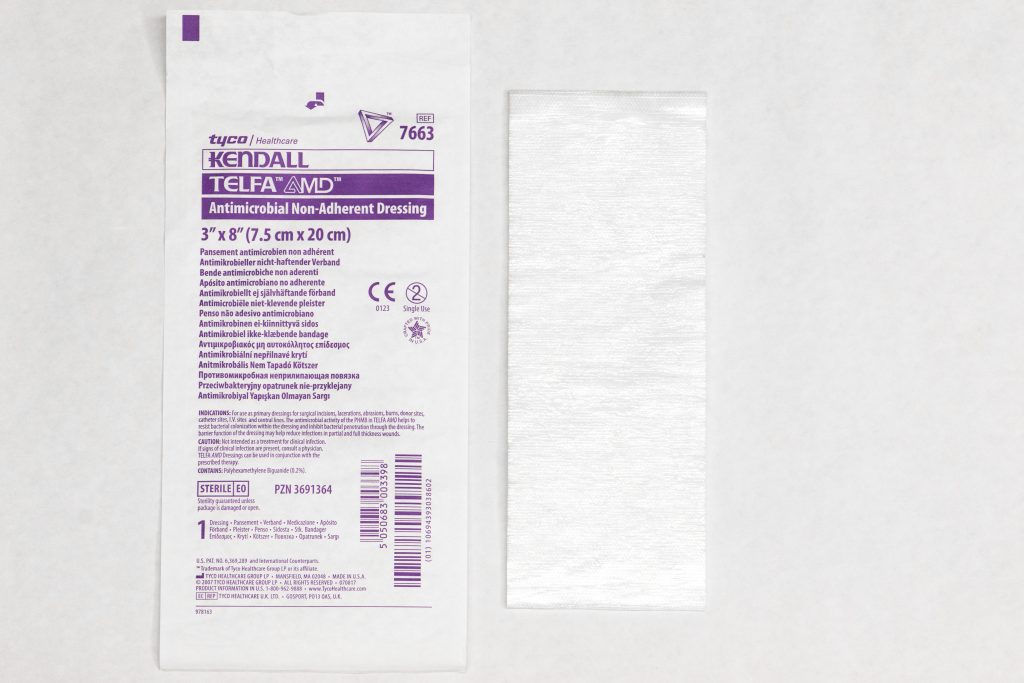
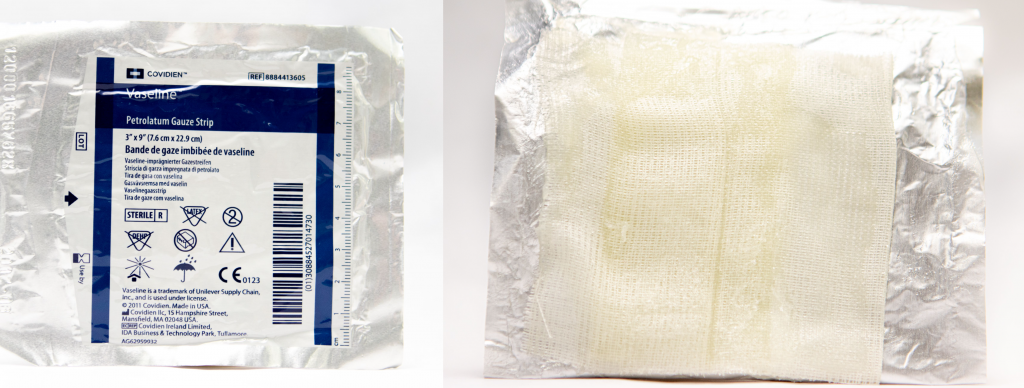
![]"Hydrocolloid.jpg" by Deanna Hoyord, Chippewa Valley Technical College is licensed under CC BY 4.0 Photo showing hydrocolloid and packaging](https://med.libretexts.org/@api/deki/files/25763/Hydrocolloid-1024x683.jpg?revision=1)
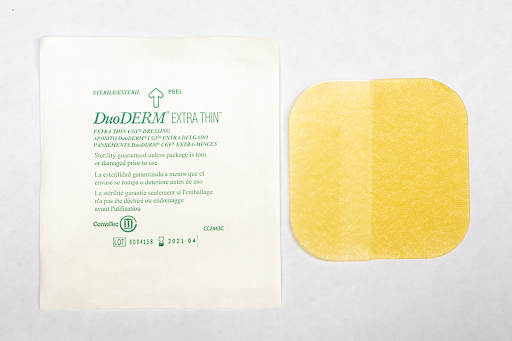
![]"Foam Dressing 3I3A0406.jpg" by Deanna Hoyord, Chippewa Valley Technical College is licensed under CC BY 4.0 Photo showing foam dressing and packaging](https://med.libretexts.org/@api/deki/files/25765/Foam-Dressing-3I3A0406-1024x683.jpg?revision=1)
!["Alginate Dressing 3I3A0396.jpg" by Deanna Hoyord, Chippewa Valley Technical College is licensed under CC BY 4.0[/footnote] Photo showing alginate dressing and packaging](https://med.libretexts.org/@api/deki/files/25766/Alginate-Dressing-3I3A0396-1024x683.jpg?revision=1)
Types of Tape
There are several types of tape that can be used to secure dressings. The most commonly used types of tape are medical transpore, micropore paper, cloth, and waterproof tape.
- Medical transpore tape (often referred to as “medi-pore”) is inexpensive, durable, and very sticky. It has tiny holes in it that allow air to reach the skin underneath and sweat and body fluid to pass through it without causing it to come off. However, it leaves residue and can damage sensitive skin.
- Micropore papertape is gentle on skin and doesn’t leave residue, but it is not waterproof and doesn’t work well on irregular areas. It allows air to reach the skin underneath.
- Cloth tape sticks well, allows air to reach the skin, and does not leave a residue. It has high strength so it can be used to secure a splint. However, it is not flexible or waterproof and can be difficult to tear.
- Waterproof tape is more expensive but it is flexible and doesn’t leave residue. It sticks well to skin but does not stick well to hair. It is waterproof when applied to dry skin.
Read Inside First Aid’s webpage about different types of medical tape:
5 Different Types of Medical Tapes and How to Use Them.
Wound Vacs
The term wound vac refers to a device used with special foam dressings and suctioning to remove fluid and decrease air pressure around a wound to assist in healing. During a wound vac procedure, the nurse applies a special foam dressing over an open wound and seals it with a thin film layer. The film has an opening that rubber tubing fits through to connect to a vacuum pump. Once connected, the vacuum pump removes fluid from the wound while also helping to pull the edges of the wound together. A person with a wound vac typically wears the device 24 hours a day while the wound is healing.[11] See Figure \(\PageIndex{9}\)[12] for an image of a wound vac foam dressing attached to suctioning by a wound vac device. Figure \(\PageIndex{10}\)[13] demonstrates the progression of a wound healing with a wound vac from image A to D.
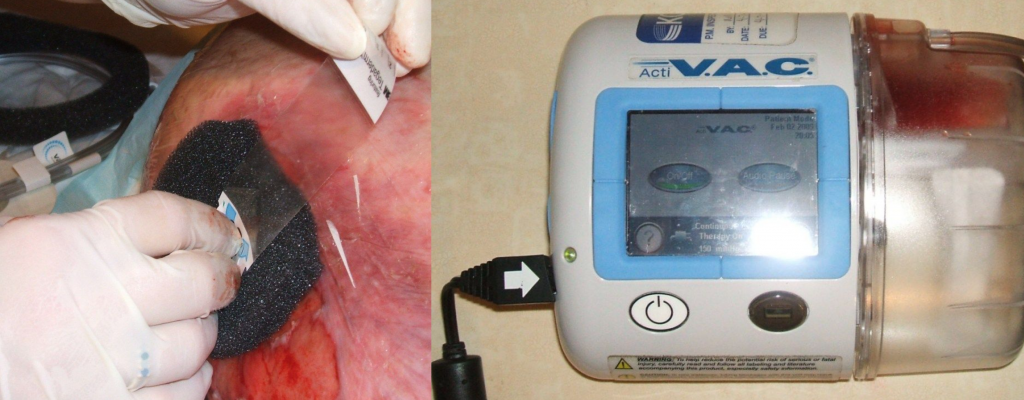
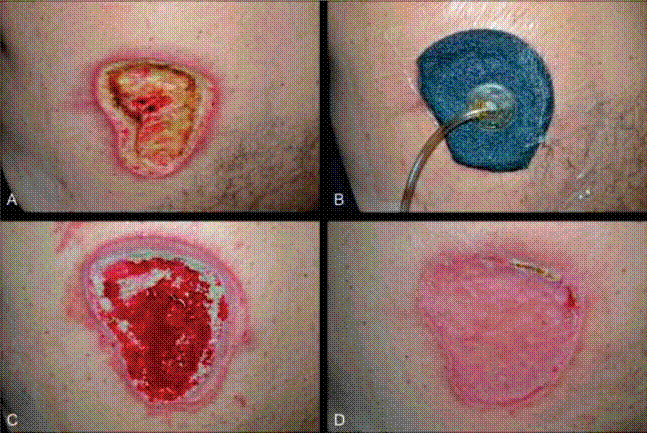
- Cox, J. (2019). Wound care 101. Nursing, 49(10). doi.org/10.1097/01.nurse.0000580632.58318.08↵
- Cox, J. (2019). Wound care 101. Nursing, 49(10). doi.org/10.1097/01.nurse.0000580632.58318.08↵
- "Sterile 4x4 Dressing and Package 3I3A0330.jpg" by Deanna Hoyord, Chippewa Valley Technical College is licensed under CC BY 4.0↵
- "Kerlix with Package 3I3A0365.jpg" by Deanna Hoyord, Chippewa Valley Technical College is licensed under CC BY 4.0↵
- "Nonadherent Dressing and Packaging 3I3A0203.jpg" by Deanna Hoyord, Chippewa Valley Technical College is licensed under CC BY 4.0↵
- "Vaseline Gauze Package -1 3I3A0296.jpg" and "Vaseline Gauze Dressing 3I3A0299" by Deanna Hoyord, Chippewa Valley Technical College are licensed under CC BY 4.0↵
- "Transparent Film.jpg" by Deanna Hoyord, Chippewa Valley Technical College is licensed under CC BY 4.0↵
- "Hydrocolloid.jpg" by Deanna Hoyord, Chippewa Valley Technical College is licensed under CC BY 4.0↵
- "Foam Dressing 3I3A0406.jpg" by Deanna Hoyord, Chippewa Valley Technical College is licensed under CC BY 4.0↵
- "Alginate Dressing 3I3A0396.jpg" by Deanna Hoyord, Chippewa Valley Technical College is licensed under CC BY 4.0↵
- Yetman, D. (2020, March 23). What you need to know about vacuum-assisted wound closure (VAC). Healthline. https://www.healthline.com/health/wound-vac#how-it-works↵
- “KCI Wound Vac01.jpg" and “KCI Wound Vac02.jpg” by Noles1984 at English Wikipedia are in the Public Domain↵
- “0100-6991-rcbc-44-01-00081-gf1.gif” by unknown is licensed under CC BY 4.0. Access for free at www.scielo.br/scielo.php?script=sci_arttext&pid=S0100-69912017000100081#f1. ↵


